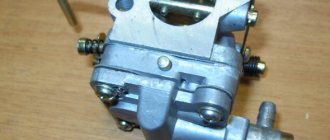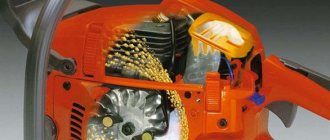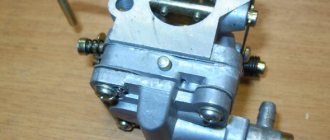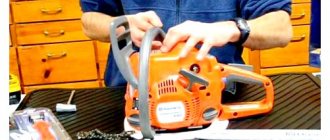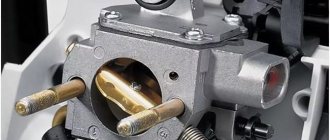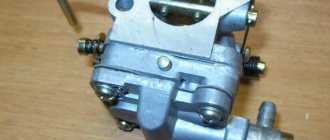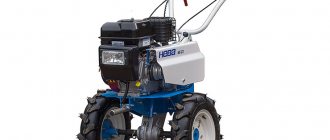The Husqvarna 5200 chainsaw is used for cleaning local areas and preparing firewood. The tool has become popular due to its high-quality spare parts, durability and high technical performance.
Advantages of the Swedish chainsaw:
- Decent power level;
- Low-maintenance motor;
- Stable speed at work and idle;
- Maintainability. Most faults can be repaired yourself. Maintenance does not require much effort, just follow the operating instructions.
Typical Husqvarna 5200 faults
Let's look at the most common ones.
The chainsaw does not start, starts and immediately stalls:
- ran out of fuel;
- low quality mixture;
- the carburetor has lost its settings;
- the ignition does not work;
- the filter is dirty;
- the spark plug has failed;
- the piston is worn.
Vibration during operation:
Recoil during operation:
- sawing with the end of a tire (prohibited);
- The guide is not installed correctly.
Safety requirements
- Fill the saw with fresh mixture.
- Start the chainsaw at a distance of at least 3 m from the refueling point.
- Do not smoke while operating or servicing the tool.
- Use personal protective equipment.
- To avoid kickback, do not cut with the end of the bar, only cut with the entire blade. lowering the chainsaw from top to bottom.
- When working, hold the chainsaw with both hands.
What is the factory setting for a Husqvarna chainsaw carburetor?
To ensure that the chainsaw will still start even if the settings are incorrect, the factory positions of the H and L screws are used. Most Husqvarna chainsaws can be started by unscrewing both screws exactly one and a half turns. Only after this can the screw positions be changed in order to achieve the desired fuel consumption and maximum operating efficiency. XX is also regulated after these manipulations.
If you still have questions about adjusting the carburetor on the Husqvarna 137 chainsaw and other models in this line, I recommend watching this
When is carburetor adjustment necessary?
The reasons why adjustment of this unit will be needed can be listed for a very long time.
Among the main malfunctions are the following:
- Increase idle speed;
- The appearance of a large amount of smoke during operation;
- Deterioration of starting properties;
- Insufficient power of the tool when cutting.
This is not a complete list of all known faults. Sometimes a procedure such as adjusting the carburetor on a Husqvarna chainsaw needs to be carried out after a major overhaul of the power plant or after maintenance.
The developers of the Husqvarna 137 write in the passport that carburetor adjustment must be carried out before and after running in the tool.
In what cases does the carburetor of a Husqvarna chainsaw require adjustment?
There are a lot of problems that can be solved by adjusting the carburetor. Adjusting the carburetor of the Husqvarna chainsaw is necessary when malfunctions such as:
This is by no means a complete list of problems that can be solved by tuning the Husqvarna carburetor. In some cases, adjusting the quality and quantity of the fuel mixture is carried out after a major overhaul of the engine or during scheduled maintenance of the chainsaw.
The manufacturer Husqvarna AB recommends adjusting the carburetor before and after break-in.
How to repair a Husqvarna carburetor with your own hands?
During operation and diagnostics, defects in the carburetor may be discovered. Most of them can be fixed independently with a minimum of knowledge and without contacting a specialized repair center.
Among the elimination methods are:
- Replacement of various gaskets at the joints of sealed parts;
- Cleaning or replacing carburetor filter elements;
- Replacement of pump elements or valves;
Almost all of the above parts can be positioned as a repair kit, which is used for minor urgent repairs of carburetors. After installing them, the Husqvarna 137 chainsaw carburetor can forget about malfunctions for a long time, and regulation will become easier.
Owner reviews
Evgeniy, 40 years old
I bought it purely for collecting firewood, for a good job once a year. The price is the same, it cuts - and thank God! In my case, professional Husqvarna models will not pay for themselves soon. I have already prepared firewood for two seasons, the saw is in good condition. I think there will be no problems in the future.
Advantages: cuts even large logs well, cheap.
Anton, 34 years old
I bought a Husqvarna chainsaw secondhand from a visiting dealer 2.5 months ago. At first I was worried that it might be fake (which was actually confirmed), but then I let go of the situation, since I still can’t afford a more expensive and original one. Externally, the saw is a little rough, the lid does not fit tightly, but it cuts perfectly. I cleaned up the trees on the site, everything I cut down was used for firewood. The chain is rather weak and gets dull quickly.
Pros: price, cuts well.
Disadvantages: none found.
Vitaly, 39 years old
I have had this Husqvarna saw for almost 2 years now and it still works. When I bought it, I knew it was a fake. It cuts any log, but it gets hot, so you have to stop often and wait until the engine cools down. The starting cable broke at the 4th month. The headset was replaced with Shtilevskaya. It cuts everything I need. I'm not making any claims. There were no instructions included in the kit; I figured it out myself, since I already had work experience.
Pros: Husqvarna cuts everything.
Disadvantages: the engine gets hot, the assembly is so-so, the chain and tire are weak, the starter is broken.
The Husqvarna 5200 chainsaw is used for cleaning local areas and preparing firewood. The tool has become popular due to its high-quality spare parts, durability and high technical performance.
READ Adjusting the Clutch on a Chainsaw
Advantages of the Swedish chainsaw:
- Decent power level;
- Low-maintenance motor;
- Stable speed at work and idle;
- Maintainability. Most faults can be repaired yourself. Maintenance does not require much effort, just follow the operating instructions.
There are a lot of nuances, we will not consider all of them in this article. Let's take a closer look at that part of the engine called the carburetor. And we will try to find the answer to the following questions: when is it necessary to adjust the carburetor of a chainsaw and, in fact, what is the scheme for such adjustment.
Chainsaw carburetor design
Before you start making adjustments, you need to know the structure and principle of operation of the carburetor. This will help avoid many “complications”. So, first, let's remember the principle of operation of an internal combustion engine. The cylinder contains fuel; when burned, it creates a small “explosion” which creates a lot of pressure. This pressure pushes the piston; the piston, when in motion, rotates the crankshaft. Ultimately, the pressure energy is converted into torque, which drives the chain through the sprocket.
During normal engine operation, it burns only up to 10 milligrams of fuel in each cycle. And the fuel mixture is prepared and supplied in the carburetor.
Thus, the purpose of the carburetor is to mix the combustible mixture with air in the required proportions. If these proportions are violated, engine operation is disrupted. For example, when mixing, little fuel is supplied, but on the contrary there is a lot of air, then such a mixture is called “lean”. And vice versa, if there is not enough air, but on the contrary there is a lot of fuel, then this is a supersaturated mixture. Both cases lead to malfunctions in the normal operation of the engine and require adjustment.
The carburetor consists of the following basic elements, and although the design may differ depending on the model, the structure and principle of operation are approximately the same:
- the basis of the carburetor is a tube, its characteristics reminiscent of a wind tunnel; air flow enters through it; An air damper is located across the tube; by its position, it either increases the air flow or reduces it;
- the tube has a narrowing. a diffuser that increases the speed of air flow exactly in the place where the fuel supply hole is located;
- the fuel itself enters the air channel from the atomizer, into which it enters through a nozzle from the float chamber (indicated in the photo as a fuel needle);
- the float chamber itself serves as a kind of reservoir, the purpose of which is to ensure a constant level of fuel at the entrance to the air channel.
The principle of operation of the carburetor is as follows. A fast flow of air flows through the air channel; its speed will also depend on the position of the damper. The float level provides the degree of opening of the fuel supply channel and depends on the position of the same air damper. The air flow, passing through the diffuser, picks up the incoming fuel and atomizes it. At this moment, a mixture is formed, which is sucked through the intake manifold into the cylinder.
In the float chamber the pressure level is approximately equal to atmospheric pressure, but in the air channel it is rarefied. Due to the pressure difference, fuel is sucked through the nozzle into the air channel. The more the air damper is open, the greater the air flow, and, accordingly, the more fuel flows. More fuel means engine speed increases.
This is the principle of operation of a carburetor. There may be nuances in its structure, but knowing how a simple carburetor works, you can always understand and determine the purpose of other elements.
In what cases is adjustment necessary?
In general, the need to adjust the carburetor of a Stihl chainsaw, or any other brand, arises quite rarely. Signs of a misadjusted carburetor are indicated by:
- the engine starts and stalls, or does not start - in this case, the cause may be a “poor” fuel mixture;
- fuel consumption has increased significantly and the amount of exhaust gases has increased (fuel does not burn completely). the cause may be an oversaturated mixture.
The adjustment itself goes wrong in very rare cases, namely:
- when the fixation of the adjusting screws was broken, there are three in total. The cause may be vibration or damage to the protective cap. This is a fairly rare case if no one touched the screws.
- in case of significant wear of the engine, namely the piston. Then the factory settings are not suitable. In this case, adjusting the carburetor of a Patriot chainsaw or another model can save the situation for a while. But here it’s time to think more about engine repair than adjusting the carburetor of a Husqvarna chainsaw or the like;
- the reason may be due to the formation of a blockage in the carburetor, the cause may be poor quality gasoline, damage to the air filter or scale. In this option, in addition to adjustment, disassembling and washing the carburetor is necessary.
Adjusting the chainsaw carburetor
Although quite rare, carburetor adjustment may still be required. Let us immediately note that not everything can be done on your own, unless you have a tachometer and at least once see with your own eyes how to do it correctly.
To adjust the carburetor of the Makita chainsaw, like most other models, there are three adjusting screws. Although some manufacturers carefully removed two of them, leaving only one for user experimentation. So, three screws, on the carburetor body they are indicated by the following letters:
- L – this screw is used to adjust low engine speeds;
- H – high speed adjustment;
- T – for adjusting idle speed (this is left for experiments).
In general, carburetors are already adjusted by the manufacturer for optimal operation, and the screws are designed for more precise adjustment of the carburetor of Champion chainsaws and others, in difficult climatic conditions such as high mountains, etc. Because the air is thinner there, the instrument requires more precise adjustments to operate. Under normal conditions this is not necessary.
To adjust the carburetor of the Goodluck chainsaw, as well as other brands, two screws L and H are used to create the appropriate quality of the fuel mixture. To create a lean mixture, the screws are turned clockwise, this allows you to increase the number of revolutions, i.e. Thus, they set high speeds. Accordingly, when turning the screws counterclockwise, the mixture becomes more saturated, this regulates the low number of engine speeds. Thus, when adjusting the carburetor of the Partner chainsaw, by turning the screws clockwise we increase the number of revolutions, and counterclockwise we decrease it.
READ What you can do with a broached miter saw
Whenever adjusting the carburetor of a Chinese chainsaw or other, a number of requirements must be observed:
- fine adjustment is always carried out when the engine is warm (engine running for at least 10 minutes);
- The condition of the air filter must be satisfactory, i.e. clean and not clogged;
- When rotating the chain using the adjusting screw T, it is necessary to ensure that it stops completely; to do this, the screw is turned counterclockwise.
And don’t forget about your own safety, the chain should be directed in the opposite direction to us, the saw should stand securely on a flat surface and not touch any objects with the cutting part. For fine adjustment, the screws are adjusted in the following sequence L. H – T. Using screw L, it is necessary to “find” the maximum number of engine revolutions. To do this, turn the screw clockwise, or in the opposite direction, until we “feel” for the maximum. This is where you need a tachometer, or a sensitive ear for music, and you should know the sound of the maximum engine speed; if you overdo it, especially with the H regulator, the engine will fail. Repairs will cost a pretty penny, so we strongly recommend entrusting this work to a professional.
If you have a tachometer and know the maximum number of revolutions of your engine, then you can try to complete the adjustment at your own risk. It will look something like this: we find the closest speed value using the L regulator, then use the same regulators to return it counterclockwise by a quarter of a turn of the screw. We leave it and move on to regulator H, and if it is over-tightened, the engine will fail.
We turn this regulator ¼ turn of the screw counterclockwise (we warm up the engine before doing this). We listen carefully or use the tachometer as a guide. If the sound is our ideal, when the engine operates at maximum, it works like a four-stroke engine. If the mixture is too rich, it makes a squealing sound. You can try to achieve an average value, not have an ideal, but remove the squealing sound with a screw. And if you are satisfied with the operation of the saw, it is better to leave it as it is, it is better than being left without an engine.
If you managed to more or less adjust the screws L and H, then all that remains is to adjust the idle speed. The ideal here is to ensure that the engine runs evenly in all positions until the chain begins to move. Rotate this screw counterclockwise until the chain stops. If this cannot be achieved, the help of a specialist is needed. An unregulated chainsaw is a very dangerous thing.
A well and correctly adjusted carburetor is:
- the chain is “standing” at idle;
- the engine accelerates quickly;
- The engine operates like a four-stroke engine.
Below is a video of adjusting the carburetor of a chainsaw
Chainsaws Husqvarna (Husqvarna) 5200
The Husqvarna 5200 chainsaw is used for cleaning local areas and preparing firewood. The tool has become popular due to its high-quality spare parts, durability and high technical performance.
Advantages of the Swedish chainsaw:
- Decent power level;
- Low-maintenance motor;
- Stable speed at work and idle;
- Maintainability. Most faults can be repaired yourself. Maintenance does not require much effort, just follow the operating instructions.
How to properly adjust a factory saw
Carburetor adjustment is divided into two main stages. The first one is called basic. It is performed with the engine running. The second is performed when the engine is warm.
adjusting the carburetor of a Chinese-made chainsaw
To carry out the carburetor setup procedure successfully, you need to read the operating instructions for a specific model in advance to identify additional features of setting up the device.
How to adjust the maximum number of revolutions
To limit this indicator, you need to use a screw marked H. To increase the number of revolutions, turn it clockwise, and to reduce them in the opposite direction. The maximum frequency should not exceed 15000 rpm.
If you make this figure larger, the device’s engine will wear out, which will lead to problems in the ignition system. When rotating this screw, you need to take into account the ignition processes of the device. If the slightest malfunctions appear, then the maximum speed value must be reduced.
Checking acceleration operation
Need to do a little research. Acceleration of the device is initiated. It is necessary to evaluate the proper operation of the engine during maximum speed. When the engine is functioning correctly, it means that when you press the accelerator, the speed quickly increases to 15,000 rpm.
If this does not happen or the increase in speed is too slow, you must use the screw marked L. It turns counterclockwise. Moderate movements must be observed, since the turn cannot be more than 1/8 of a full circle.
Algorithm and description of Husqvarna carburetor settings
The Husqvarna carburetor is adjusted in the same way as carburetors on chainsaws from other manufacturers are adjusted.
Immediately before adjustment, it is necessary to conduct a complete diagnosis of the saw and make sure that there is no difficulty in supplying fuel or air leaks into the crankcase of the chainsaw. You also need to make sure that the air filter is clean and, if necessary, replace it with a new one.
The work order is as follows:
- On the muffled saw, the factory settings of the Husqvarna carburetor are installed.
- The engine starts and the saw warms up for several minutes.
- By turning the screw (L) clockwise, the position at which the engine develops maximum speed is found, after which the screw must be turned back 1⁄4. If the chainsaw chain rotates, then it is necessary to reduce the idle speed by adjusting the position of the screw (T).
- The next stage is adjusting Husqvarna's power at maximum speed and adjusting its quantity. To do this, the tachometer is connected to a running chainsaw, the throttle is squeezed to full, after which the tachometer readings are checked. If the maximum speed value differs from the maximum number recommended by the manufacturer, then by changing the position of the screw (H), the tachometer readings are returned to normal.
About the carburetor design
The carburetor is used to mix the combustible mixture with air in compliance with predetermined proportions. If the exact doses are not observed, the engine's proper functioning is at risk. When, during mixing of components, a large amount of air enters, but not enough fuel, then such a mixture is considered “lean”.
Oversaturation should not be allowed, since a large amount of fuel compared to air can also cause malfunctions or engine wear. Carburetor adjustment is needed not only before initial use, but also when any deviations in its operation are detected. Before starting to work with a chainsaw, do not forget to run it in.
The carburetor design contains a standard set of elements, but may vary slightly depending on the manufacturer. Components:
- The basis. This is a special tube that is visually similar to an aerodynamic design. Air passes through it. In the transverse direction, a damper is located in the middle of the pipe. Its position can be changed. The more it is extended into the passage, the less air enters the engine.
- Diffuser. This is the constricted part of the tube. With its help, the air supply speed increases precisely in the segment from which the fuel comes out.
- Channels for fuel supply. The fuel mixture is contained in the float chamber, then passes into the nozzle, from which it flows into the atomizer.
- Float chamber. It is a separate structural element, reminiscent of the shape of a tank. Designed to constantly maintain the optimal level of fuel fluid before entering the channel from which air enters.
READ How to lubricate a chainsaw tire sprocket
Don't know which chainsaw to choose? Read our article.
Are you looking for cheaper models, but reliable and time-tested? Pay attention to Russian-made chainsaws.
Or check out foreign chainsaw manufacturers such as Stihl.
Final check at idle
Before this procedure, it is necessary to carry out a full adjustment of the carburetor components when operating at maximum speed. Next, you should check the functioning of the device in idle cold mode. When the correct adjustment parameters are achieved, you will notice that the carburetor design closely matches the following criteria:
- When the idle cold mode is activated, the chain does not move.
- When the accelerator is pressed even slightly, the engine accelerates at an accelerated pace. With gradual deepening of pressure, you can notice that the engine speed increases proportionately, reaching the maximum permissible values.
- When the engine is running, you can compare its sound to a four-stroke device.
If violations are noticed in the given parameters or the device has not been fully adjusted, you need to perform the main setup step again. Sometimes actions are performed incorrectly. In this case, the device may fail due to the loss of the correct node settings. In this case, you will have to contact a specialist.
How to adjust the carburetor on a chainsaw and correctly set the idle speed with your own hands
To independently adjust the carburetor, you need to familiarize yourself with its structure and remember the order of work that is carried out to adjust the parts responsible for the proper functioning of the component elements of the device and parts adjacent to it. You need to carefully handle objects to adjust the chainsaw system, and also determine whether the set parameters correspond to the maximum permissible values.
First stage
The adjusting screws for the highest and lowest speeds should be moved clockwise until the highest resistance is met. When the screws reach the stop, you need to move them in the opposite direction and leave them 1.5 turns.
What you need to have to set up and adjust a chainsaw with your own hands
Each carburetor owner must have the necessary tools to adjust this system. There are three adjustment screws that are located on the body of the device. They have their own markings:
- L - screw for correcting low speeds.
- H - screw for adjusting high speed.
- T - regulates idle speed, in most cases used for experiments.
Chainsaw air filter
Before adjusting the carburetor, you need to prepare the device:
- The engine warms up, that is, it starts about 10 minutes before repairs, and turns off when starting work (see how to start a chainsaw).
- The air filter is checked and washed.
- The chain is stopped by turning screw T until it stops (see chain oil).
To carry out a safe repair, you need to prepare a flat surface where you can carefully place the device and turn the chain in the opposite direction. Need a tachometer. It determines whether there is a malfunction in the carburetor. When turning the screws, the sound should be perfect and absolutely smooth. If you notice squealing notes, the mixture is oversaturated.
When is carburetor adjustment necessary?
The reasons why adjustment of this unit will be needed can be listed for a very long time.
Among the main malfunctions are the following:
This is not a complete list of all known faults. Sometimes a procedure such as adjusting the carburetor on a Husqvarna chainsaw needs to be carried out after a major overhaul of the power plant or after maintenance.
The developers of the Husqvarna 137 write in the passport that carburetor adjustment must be carried out before and after running in the tool.
Situations in which adjustment is necessary
New chainsaws are supplied by the manufacturer with already adjusted carburetors. This is called standard adjustment. But for the normal running-in process, it is necessary to reduce the maximum engine speed and adjust the carburetor. After break-in, the chainsaw needs fine tuning to achieve maximum engine efficiency.
Also, a signal for cleaning and adjustment is increased fuel consumption, which negatively affects the operation of the exhaust system. Simply put, the chainsaw begins to smoke heavily and the muffler becomes clogged with carbon deposits, which in turn will lead to a decrease in power.
If there is too much fuel in the mixture, engine parts are poorly lubricated and premature wear occurs. Also, a poor quality mixture can cause the engine to jam due to overheating (this is one of the reasons why the chainsaw will not start).
This is what a jammed, overheated piston looks like from a disassembled chainsaw with an incorrectly configured carburetor.
Adjustment is necessary when the engine does not idle, stalls, or does not develop full power. Carburetor adjustment should be carried out with clean air and fuel filters. We also recommend reading an interesting article that details the main reasons why a chainsaw starts and immediately stalls.
How to repair a Husqvarna carburetor with your own hands?
During operation and diagnostics, defects in the carburetor may be discovered. Most of them can be fixed independently with a minimum of knowledge and without contacting a specialized repair center.
Among the elimination methods are:
- Replacement of various gaskets at the joints of sealed parts;
- Cleaning or replacing carburetor filter elements;
- Replacement of pump elements or valves;
Almost all of the above parts can be positioned as a repair kit, which is used for minor urgent repairs of carburetors. After installing them, the Husqvarna 137 chainsaw carburetor can forget about malfunctions for a long time, and regulation will become easier.
How does the carburetor work on a Husqvarna 137 chainsaw?
Chainsaws of these models are most often equipped with a Walbro carburetor from the factory. Before adjusting the Walbro carburetor on a Husqvarna chainsaw, you need to have a minimal understanding of its structure and know the principle of operation.
What is responsible for supplying the mixture of fuel and oil
For precise supply of fuel and oil, the operation of a fuel pump is used, which is driven mechanically from the crankshaft. The carburetor itself is equipped with a diaphragm and a special needle valve, which are responsible for regulating the pressure in the system. Thanks to them, the correct operation of the dosing chambers and the pump is organized, which improves the operation of the chainsaw.
Preparing the fuel mixture
When operating a chainsaw, a fuel mixture of gasoline and oil should be used in a ratio of 15:1 by volume, i.e., 1 liter of oil should be added to 15 liters of gasoline and the mixture should be mixed thoroughly. The amount of gasoline and oil in the fuel mixture is given in this table:
ATTENTION! Application of oils: “Lukony-2T; TNK-2T OIL: AZMOL Sport 2T GD”, etc., and waste oil in the fuel mixture will lead to failure of the connecting rod needle bearing.
What you should pay attention to?
Once the Husqvarna carburetor adjustment is completed, you need to make sure that the engine is running smoothly and that the saw easily picks up and drops the required speed. The rotation of the chain at idle is considered abnormal, so its connection with the clutch must be adjusted again using screw H.
Do not forget that the unit is not adjusted immediately: you need to wait some time, since the Husqvarna chainsaw does not immediately respond to changes in the position of the screws. This time can range from 5 to 15 seconds. This time is not indicated in the table, so you can only find out experimentally.
If after adjustment a huge amount of smoke appears during operation, then you need to adjust the supply of the fuel and oil mixture. For these purposes, rotate screw L.
Sources:
https://strport.ru/instrumenty/regulirovka-karbyuratora-benzopily https://machinspec.com/lesozagotovitelnaya/benzopila/nastrojka-karbyuratora.html https://prokarbyrator.ru/regulirovka-karbyuratora/regulirovka-karbyuratora-benzopily- huskvarna-137-svoimi-rukami.html
The design and principle of operation of the Husqvarna carburetor
To successfully configure the Husqvarna chainsaw carburetor, you need to know its structure and understand how it works. In fact, everything is not as complicated as it seems at first glance.
The saw carburetor has a built-in fuel pump, which is responsible for transporting the mixture of gasoline and oil, as well as a diaphragm, a needle valve with a rocker arm. Their joint work makes it possible to dose the fuel supply to the main chamber and two dampers.
One of the dampers is designed to regulate the flow of fuel into the cylinder when you press the gas, it is called the throttle, the second is responsible for limiting the flow of air from the air filter to facilitate starting a cold Husqvarna chainsaw. At the moment when the operator shuts off the air supply to the carburetor using the air damper, the fuel mixture becomes leaner and its supply to the cylinder increases, due to which the chainsaw starts much easier than when a cold start is carried out in normal mode.
The operation of the Husqvarna carburetor involves a valve-nozzle, which atomizes fuel and prevents air from entering the main chamber. Often problems with saw operation can be caused by defects in this particular element. For example, if the chainsaw is stored improperly, the valve may stick, the fuel supply will stop, which will make the engine impossible to operate. Also, malfunctions in the operation of the nozzle can cause air to leak into the main fuel chamber of the carburetor. In such cases, adjusting the position of the adjusting screws will not correct the situation; repair or replacement of the unit will be required.
Three adjusting screws installed in the carburetor body are responsible for adjusting the quality and quantity of the mixture, as well as the number of crankshaft revolutions in idle mode:
- screw (L) – regulates the amount of fuel in low and medium speed modes;
- (H) – responsible for traction at high speeds and their number;
- (T) - changes the position of the throttle valve, thereby regulating the amount of fuel mixture entering the cylinder and the operation of the tool engine in idle mode.
Screws (L) and (H) cannot be adjusted without specific knowledge and experience. Incorrect adjustment of the quality and quantity of the fuel mixture can cause the engine to stop working or operate incorrectly, causing it to wear out quickly or even seize.
